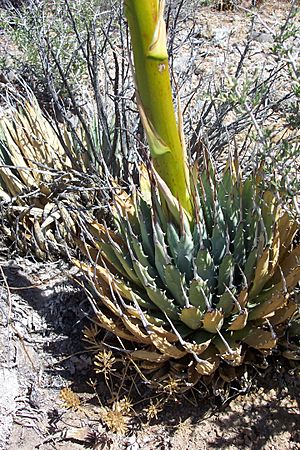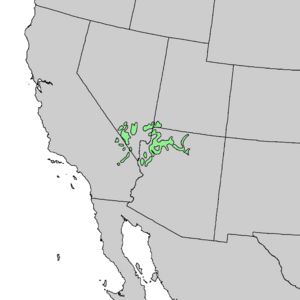Utah agave facts for kids
Quick facts for kids Utah agave |
|
|---|---|
 |
|
| Conservation status | |
| Scientific classification | |
 |
|
| Natural range of Agave utahensis | |
| Synonyms | |
|
The Agave utahensis is a type of agave plant. It is often called the Utah agave. This plant has different kinds, like the Nevada agave and the Kaibab agave.
You can find the Utah agave in the desert areas of the southwestern United States. It grows in states like Utah, Nevada, Arizona, and California. Even though some groups of these plants might be at risk, overall, the species is doing well. Experts say it is of Least Concern, meaning it is not currently in danger of disappearing.
What Does It Look Like?
The Utah agave grows in a shape like a big rose, called a rosette. Its leaves are blue-green and have sharp points.
When it blooms, it grows a very tall flower stalk. This stalk can reach up to 4 meters (about 12 feet) high! The flowers are usually yellow or yellow-green and look a bit round. After the flowers, the plant makes fruits that are small capsules. These capsules are 1 to 3 centimeters long and hold black seeds inside.
How Is It Used?
The Agave utahensis is grown as an ornamental plant. This means people plant it because it looks nice in gardens. In the United Kingdom, it even won a special award called the Royal Horticultural Society's Award of Garden Merit. This award shows it is a great plant for gardens.
Long ago, Native American people used this plant for many things. Groups like the Havasupai used it for food and to make strong fibers. These fibers could be used to weave things. The Navajo also used parts of the plant to make blankets.
See also
 In Spanish: Agave utahensis para niños
In Spanish: Agave utahensis para niños


